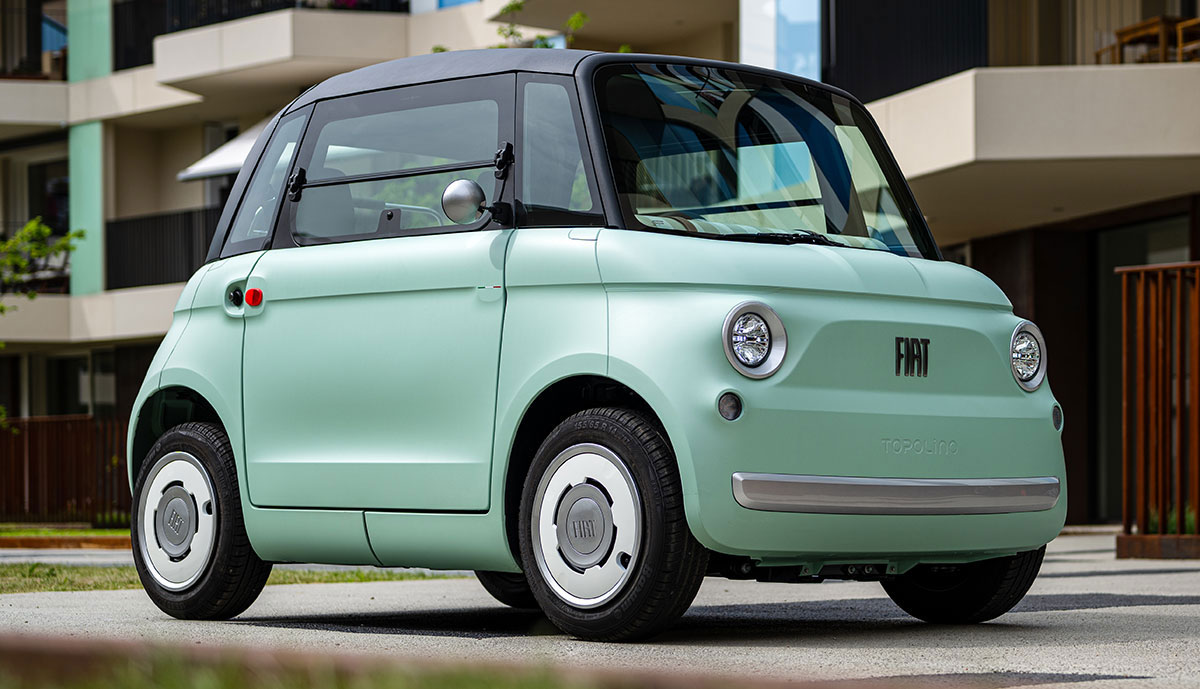Und Fiat hat es geschafft, was weder Opel mit dem Rocks-e, noch CItroen mit dem Ami hinbekommen haben: er sieht einfach gut aus!
Muss mich schwer zurückhalten, meine Finanzen jetzt nicht spontan zu ruinieren und das Ding zu bestellen… Aber es würde sich langfristig vermutlich auszahlen, wenn dafür endlich das bisherige Auto wegkommen würde…
Ich finde es immer noch eine Schande, was aus dem Opel E-Manta Konzept geworden ist. Vom wirklich schönen kleinen retro wagen zum generisch-hässlichen SUV.
Warum 45km/h? Warum nicht 50? Warum nicht den elektrischen Verkehr mit den verbrennern mitfließen lassen? Genau das gleiche bei E-Bikes: warum bei 25 abriegeln? Warum nicht 30?
Weil isso.
Gruß V. W.
Edit: Weil much das selber tierisch nervt habe ich angefangen das nachzugucken. Zumindest der 25km/h Teil wird bei Quora von Jakub ziemlich plausibel so erklärt:
To understand why there is the 25 km/h limit in EU dates many years back - first halve of nineties namely, when the European legislation mentioned “low performance mopeds” for the first time. The speed was specifically made for Germans MoFa (motor-fahrrad) mopeds with minimum age is 15 and no driver license required. About this years Yamaha corporation also lobbied the EU to allow import of he new-born category of Yamaha PAS bicycles - predecessors of today’s e-bikes. The legal speed of electrified pedal assist bicycle in Japan was - and still is 24 km/h.
Council Directive 92/61/EEC (June 1992) relating to the type-approval of two or three-wheel motor vehicles mentioned future separate directives to lay down specific requirements for “low-performance mopeds with pedals, with an auxiliary engine of power not exceeding 1 kW and a maximum design speed not exceeding 25 km/ h”.
That happened in Directive 2002/24/EC of the European Parliament (March 2002) relating to the type-approval of two or three-wheel motor vehicles repealing Council Directive 92/61/EEC.
Here we can see the exclusion for “cycles with pedal assistance which are equipped with an auxiliary electric motor having a maximum continuous rated power of 0,25 kW, of which the output is progressively reduced and finally cut off as the vehicle reaches a speed of 25 km/h, or sooner, if the cyclist stops pedalling” for the first time. Very probably the creators of the legislation took this limit for the previous act without the real existing product
When the first modern e-bikes started appear in Europe - 2004 in Netherlands already 22.000 e-bikes were sold according to BOVAG - and few years later the boom started Germany and Italy, all products matched this Directive. That time the target consumers were 60+ pensioners and 25 km/h seems to be quite sufficient for their cycling routines.
Yet it was still “just” Directive - generally a non binding document in the EU countries national legislation. So stronger calibre was needed and thus the motorcycle lobby pushed REGULATION No 168/2013 (January 2013) on the approval and market surveillance of two- or three-wheel vehicles and quadricycles. This EU wide legally binding document contains similar exclusion only for “pedal cycles with pedal assistance which are equipped with an auxiliary electric motor having a maximum continuous rated power of less than or equal to 250 W, where the output of the motor is cut off when the cyclist stops pedalling and is otherwise progressively reduced and finally cut off before the vehicle speed reaches 25 km/h;”.
The market in 2019 is totally different from 2004, or 2014. From the “few crazy seniors” today e-bikes does have a chance to become a primarily commuting vehicle for masses. But not at 25 km/h for sure.
Speed limitation resulted in 2016 the category of so called “Fast pedelecs” vehicles who fall under L1e-B category with maximum design vehicle speed of 45 km/h and a maximum continuous rated power of 4 kW (!). Many brands introduced their vehicles, but customers does ignore them. The compulsory drivers licence, registration, insurance, licence plate, special helmet and certifications, along with very high price makes this category totally obsolete.
The other effect is chipping. Since all major central e-bike engine producers (Bosch, Bafang, Yamaha, Shimano, Brose…) build their motors with 45 km/h capability (or 32 km/h for US markets), the speed is only an software issue. From fancy speed sensor perplexity, till very advanced micro PCB´s installed on the motor internal service connector and allowing to speedup e-bike on a singe click. The unofficial statistics from Germany speak about over 70% of all e-bikes chipped until 6 months after sale. Here in Czechia the number is even higher, every 8 out of 10 e-bikes are being chipped until 2 months, when the owner realise that 25 km/h is not they expect from the product.
So, why the European politicians will not simply vote for higher speed? Its not easy, if you see the e-bike drive-train suppliers, most of them have high turnovers with automotive business. Of course, the higher speed / usability of e-bikes will very fast result the (already) declining market with light scooters and motorcycles.
I personally believe that 32 km/h (20 mph) is perfect speed. We did a number of trials with customers, letting them ride the same e.bike adjusted to 25–32–45. Only 23% were happy to ride 25 km/h, but more than 80% find the 32 km/h sufficient for their electric bike usage.
To keep the 25 km/h limitation will hurt the e-bike business badly in next years. The users with chipped bikes will persecuted and ostracised. Police will be more aware and instructed (already happening in Germany).
There is EU Petition for this topic, can be found under http://www.32kmh.eu. To signup the petition may make the EUParl members aware of it and theoretically can help to open adequate discussion.
Was er dabei bisschen vernachlässigt: Radler haben in DE auf Radwegen zu fahren (es sei denn…) und 30km/h ist eine Straßenvorschrift. Nicht Radweg.
Ja, das ist total willkürlich. Aber deswegen würden S-Pedelecs ja auch deutlich mehr Sinn machen wenn die bis 55km/h fahren dürften wenn die eh schon auf der Straße fahren müssen.
Ich würde den fahren. Für die Stadt ideal.
Finde es immer cool wenn alte Modellnamen wiederbelebt werden :D
Der ist nicht zufällig mit dem Citroën Ami verwandt? Sehe da bis auf die “Türen” große Ähnlichkeiten.
Gibt auch noch den Opel rocks. Der rocks ist sehr nah am Citroen. Bei den beiden sind nicht nur die Türen gleich( auch links und rechts! Die rechte Tür hat ihr Scharnier in Fahrtrichtung hinten, die linke in Fahrtrichtung vorn.), sonder auch die Front und das heck. Nur eben statt weissen leichten rote. Aber die Gussteile sind gleich.
Die rechte Tür hat ihr Scharnier in Fahrtrichtung hinten, die linke in Fahrtrichtung vorn
Ist ja wild, das wusste ich gar nicht.
Der ist nicht zufällig mit dem Citroën Ami verwandt? Sehe da bis auf die “Türen” große Ähnlichkeiten.
Ganz genau, die teilen sich das Grundgerüst.
https://de.wikipedia.org/wiki/Citroën_Ami_(2020)
Ich finde die fein. Aber wegen der Ladehäufigkeit und Langsamkeit sollte man das Ding Zuhause laden können. Hat eh einen Schukostecker, eine Wallbox ist also nicht nötig.






